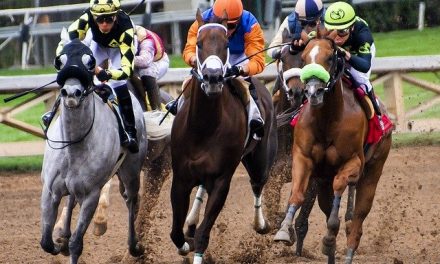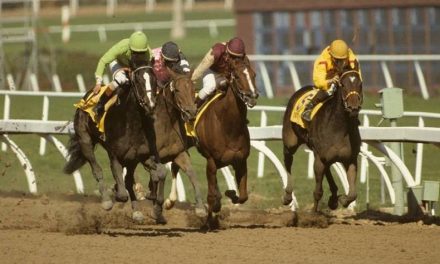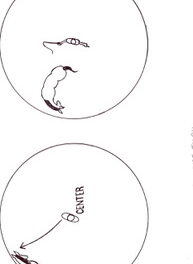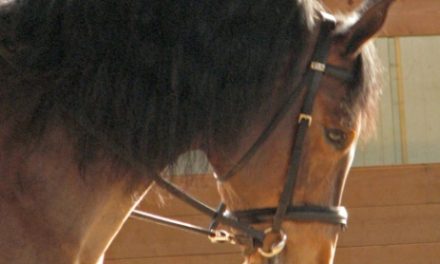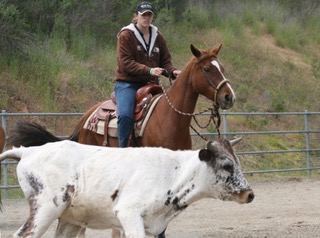
I was very excited when American Quarter Horse Association
(AQHA) Ranch Versatility was first introduced. Ranch Pleasure or
Ranch Riding as it is now called is great because it requires the
horse to have good forward movement. When I was showing in my
younger years Western Pleasure at that time also required good
forward movement. Somewhere along the line the discipline began
to require the horse to move much slower, with what I call the
crippled canter and that to me is not pleasant to observe or good
for the horse physically.
The idea of Ranch Riding is that it is a pleasure to ride and watch.
We are looking for a natural headset that is at least at or above the
withers. With any head carriage below the withers the horse will be
on the forehand. There won’t be a nice fluid forward movement
when the horse is on the forehand. You want the horse to carry
itself naturally, in a balanced frame. With a low headset if you
were really out riding on a ranch, the horse would not be able to
see where it was are going. Ranch Riding is based on movement
and what a horse can do out in open country. There are hills to
climb, objects to avoid and you want the horse to be aware.
When the riding pattern calls for a walk, it needs to be a ground-
covering walk. The walk must have purpose; it must be a “go some
place” walk. The horse needs to be aware of the surroundings.
With a good ranch horse, sometimes the horse being alert can
help the rider by, for instance, sighting cows. They are able to pick
up on movement and sounds quicker than a horse that has its head
down and is plodding along. The walk should be comfortable for
the rider and give the impression that the horse is ready and
attentive to do whatever the rider asks.
What I call a working trot and some people call a jog, while not
extended also needs to cover ground. It should be comfortable for
the rider because if it is not comfortable, by the end of the day both
the horse and rider will be very tired. With a nice forward trot, you
can cover a lot of territory and save a lot of wear and tear on the
horse because you do not have to canter to cover a lot of distance.
We are looking for a ground covering, smooth trot that is a
pleasure to ride and watch.
A ranch horse should be driving from behind. A fast trot does not
equal a better extension. For some riders, an extended trot means
going faster. An extended trot is not faster but while you may go a
little faster, covering ground a bit more, it is really a lengthening of
the horse’s stride. We want the horse to be balanced, moving with
the hocks tracking under and driving from the rear. It is also
important for the horse to be smooth in its movements.
When you are loping your horse in a riding pattern, a ground-
covering lope is essential. The horse must be driving from behind
and giving the impression that it would be comfortable and a real
pleasure to ride the horse all day long. We want to see contact with
the mouth because on a ranch if a cow was to take off or spook we
don’t want the rein dragging on the ground. By the time you pick
up a loose rein to get a hold of the horse, the horse will be down
the trail at full speed. At the same time, you don’t want to be
holding the horse back, or riding the brakes. You want a nice soft
rein with a little bit of soft droop to it. I think the contact is also
important because when you have a drooped rein, you have no
contact with the horse. That contact is part of your communication
with the horse.
I’m not poking fun but many times it is interesting to watch cutters
lope. I like to watch them lope in the warm up pen. They lope
around with a big, droopy rein and all the horses are on the front
end, angled down. Just about everything we do not want to see.
One time I spoke with a fellow who had come to the barn to work
with one of my clients and I offered him a mare that I thought he
would like to ride. We saddled her and he went out loping around
and he was a good rider. Her head was down below the withers,
almost between her knees. The reins were droopy and I got a little
concerned. I called to him and suggested he pick up the rein a bit
to take out some of the slack. What a difference in the balance of
the horse. The change was significant even though he did not go to
full contact. The weight of the rein allowed contact and the horse
was able to balance herself. It is important to remember that you
can have contact with the horse without being heavy on the reins.
When you ride with a slack rein there is no contact, no
communication and the horse will be heavy on the forehand.
Part II will provide more information on Ranch Versatility. See
you next time.
Charles Wilhelm

